What Do I Do When Baby Chicks Are Poking Eggs and Making Them Bleed
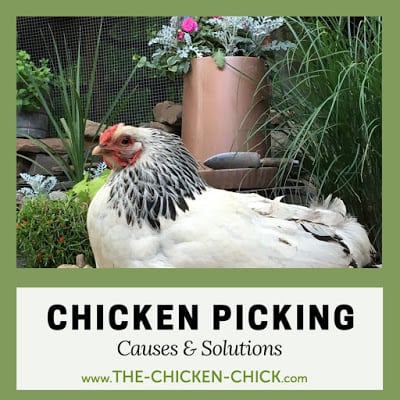
Feather and skin picking is a serious problem beliefs exhibited by chickens under stress. If the stress is not identified and alleviated, plume picking can degenerate into a flock-wide problem with deadly results. Chickens learn picking behavior from each other, so ending unwanted picking equally before long as it begins is critical to avoiding a bloody epidemic. One time the cause of the stress is determined, it'southward usually adequately piece of cake to stop the picking past making pocket-size adjustments in the flock. So, allow's take a look at chicken picking risk factors, prevention and solutions.

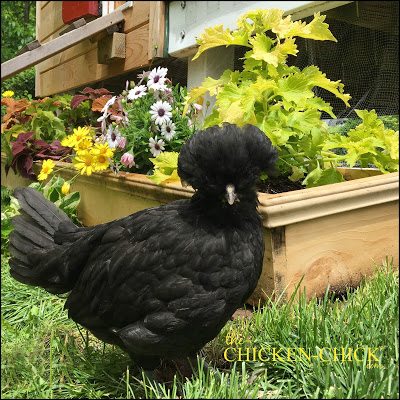
Chance FACTORS FOR PICKING
Change of whatsoever kind
Moving (from hatchery to feed store to home, etc)
Crested breeds
Chicks chilled during transport
Nutritional deficiencies
Changes in nutrition
Crowded living weather condition
Excessive heat or light from heat lamps
Poor ventilation
Empty feeders or waterers
Boredom
New feather growth
Harassment from animals or children

PECKING PREVENTION & SOLUTIONS:
CROWDED LIVING SPACE
A chicken is naturally inclined to provender for food by scratching and pecking at the ground. When also many chickens occupy too modest a space, pecking opportunities are limited and chickens get on each other's nerves. Assailment can outcome from overcrowding which leads to feather picking and cannibalism. Birds without acceptable personal infinite will as well beginpicking at novelties on ane another such every bit a fleck of dirt, a feather shaft, or an insect. Innocent exploration very hands results in small skinwounds. Chickens are drawn to the sight and salty flavor of blood and one pocket-size skin wound tin apace become life-threateninginjuries inflicted past many chickens. By nature, chickens are cannibalistic- they can and will kill another chicken.
SOLUTION
Ample space essential to happy, healthy chickens. When too many chickens occupy too small a space, the natural inclination to peck and scratch the ground is limited, which tin event in aggression and impulsive picking of feathers and skin. Small peel wounds can get life-threatening injuries.
The bare minimum living infinite for a twenty-four hours old chick is 6 square inches. Visualize an viii.5" 10 11" piece of newspaper and permit at least that much space for two brand spankin' new infant chicks. Increment the size of the brooder as chicks increment in size. Read about building achick condo that expands every bit chicks do, here. Introduce novelties andboredom-bustertype activities to chicks such asa sand box for dust bathing, aroosting bar, a shatter-proof mirror, or hanging treats for pecking, just resist the temptation to rely ontreats for regular entertainment- theirs and yours.*Safety notes: neither a plumage duster nor cord should exist used in a brooder due to the risk of entanglement and ingestion. Always offer chicks dust to help in the digestion of fibrous treats.
For older birds, the minimum living infinite inside the coop is four square feet per bird and 10 foursquare feet within a closed chicken run. If chickens are confined primarily to the coop and run daily, a much greater infinite assart must exist made to avoid boredom and feather picking.
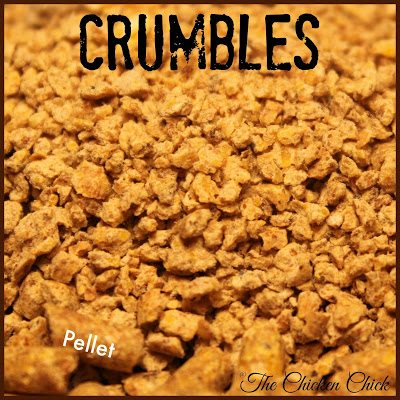
NUTRITIONAL DEFICIENCIES
Chickens that are deficient in protein, sodium and/or other dietary essentials can resort to picking. Feeding chickens as well many treats can interfere with their daily nutritional requirements. Provide an age-appropriate, nutritionally consummate chicken feedand limittreats/snacks/extras- even healthy choices– to no more than 5% of their full daily diet.15 Minute Rule:Any treats that have non been consumed within 15 minutes should be cleaned up and tending of so as not to dilute the complete nutrition in their feed.
Chickens that are scarce in protein, sodium and/or other dietary essentials will seek out sources of the defective nutrient(s) to satisfy their dietary needs. The deficiency can cause a chicken to peck excessively at their ain preening gland, the feathers effectually it and feathers of other birds. Protein-deficient birds may pick and consume feathers. Feeding chickens besides many treats/snacks/fruits/ veggies/kitchen scraps can interfere with daily nutritional requirements, causing aggression and trouble picking behaviors.

This is the preening gland, located at the base of operations of the tail feathers. Oil in the gland is salty & hens volition over-work the gland when deficient in certain nutrients.
SOLUTION
Provide a nutritionallycomplete feed appropriate for the age of the bird. No more five% of a chicken's daily diet should consist of extras other than craven feed. Obesity is a major problem in backyard laying hens, just nutritional deficiencies can crusade other wellness and behavior problems and cut lives short.

MOLTING AND Plumage GROWTH
Molting is the natural, regular shedding of old feathers and growth of new ones, which is frequently accompanied by the presence of bald areas of skin. While molting occurs at adequately regular intervals for each chicken, and ordinarily begins as daylight hours shorten at the end of summertime, information technology can occur at whatsoever fourth dimension due to lack of water, food, or sudden alter in normal lighting weather. Molting occurs in a anticipated gild beginning at the head and neck, proceeding down the back, breast, wings and tail. Chickens are vulnerable to pecking during a period of plume re-growth due to the visible presence of claret in the newly emerging pivot feathers.
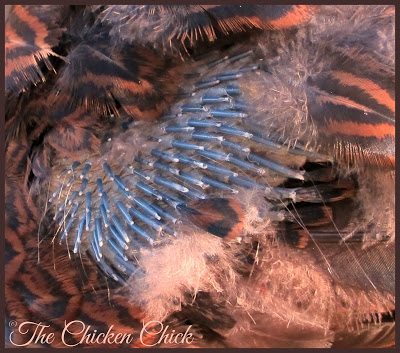
Emerging pivot feathers contain a blood-filled vein that can attract unwanted attending from other birds.
SOLUTION
Be on the lookout for broken pin feathers during a molt and immediatelydivide any bird with damaged or bleeding pivot feathers from the flock to foreclose further injury.

Freida is just re-growing feathers after a period of broodiness. Someone had been picking at her pin feathers every bit evidenced by the cleaved feather shafts and blood.
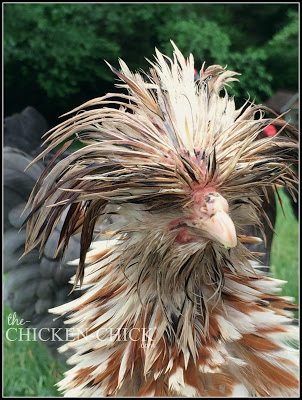
CRESTED BREEDS
Breeds with fancy caput feathers (Polish, Silkies, Houdans, etc.) are at increased run a risk for having their head feathers picked past other birds particularly when the feathers get wet or the bird is molting.
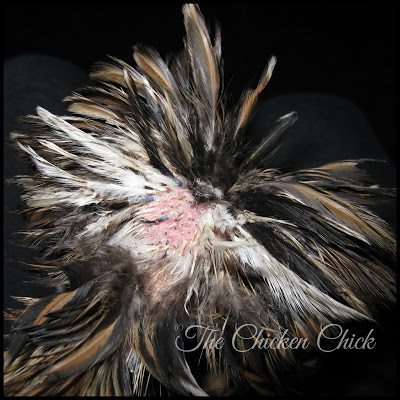
SOLUTIONS
Putting crest feathers in a ponytail on top of the head sometimes works to comprehend baldheaded spots, hibernate pin feathers and to hide the scalp. Trimming feathers around the eyes can improve the bird's ability to meet problem coming and get out of the mode of flockmates' busy beaks. Read more than almost caring for crested breeds here.
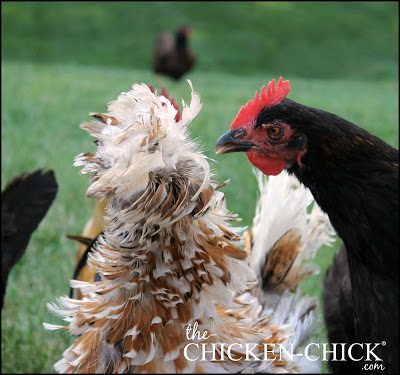
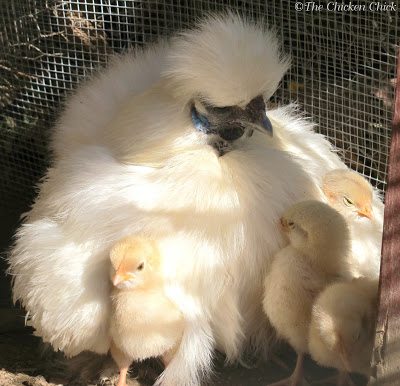
BROODY MOLT
Broody hens tend to molt furiously afterwards a menses of broodiness when she returns to normal eating and drinking routines and her hormones return to normal levels.
SOLUTION
Suspension up broody hens that volition not be permitted to hatch eggs to stop the hormone roller-coaster and forestall a prolonged interruption in normal eating, drinking and elimination routines. Later a hen has hatched chicks, feed her and her chicks starter ration, which will help supply her with the college protein needed for plumage production.
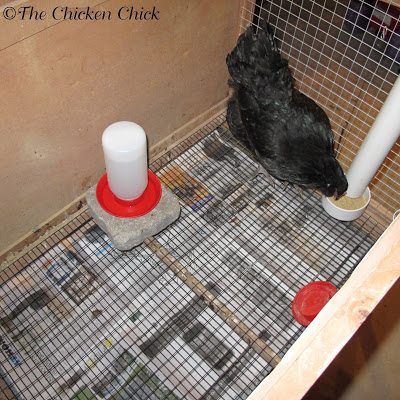
The Broody Billow: a temporary, wire-bottomed housing unit of measurement that discourages broodiness.
Colorlessness
Just as with children, bored chickens volition get into mischief. Chickens that are confined primarily to the coop and run daily are more inclined to begin featherpicking out of boredom and marvel than costless-range chickens. Free-range chickens seldom run into trouble with boredom, but when inclement weather prohibits free-ranging,boredom-busting activities can be offered. Chickens kept on arestricted feeding programvs free-feeding regimen may become bored in between feedings, leading to feather picking and problem pecking.
SOLUTIONS
Free-feed chickens instead of timed feedings. Being allowed to selection upwards minor amounts of feed often throughout the day eliminates competition for feed and provides an activity with a purpose. Provide feed in crumbles form instead of pellets to extend the amount of time birds spend procuring feed to satisfy their appetites.Treats or snacks can be employed equally an occasional distraction, just should not be relied upon as a primary class of amusement. No more than two tablespoons of any given dietary extra (treats, snacks, veggies, fruits, etc) and not every mean solar day. Innovateboredom-buster type activities that offering exercise opportunities.
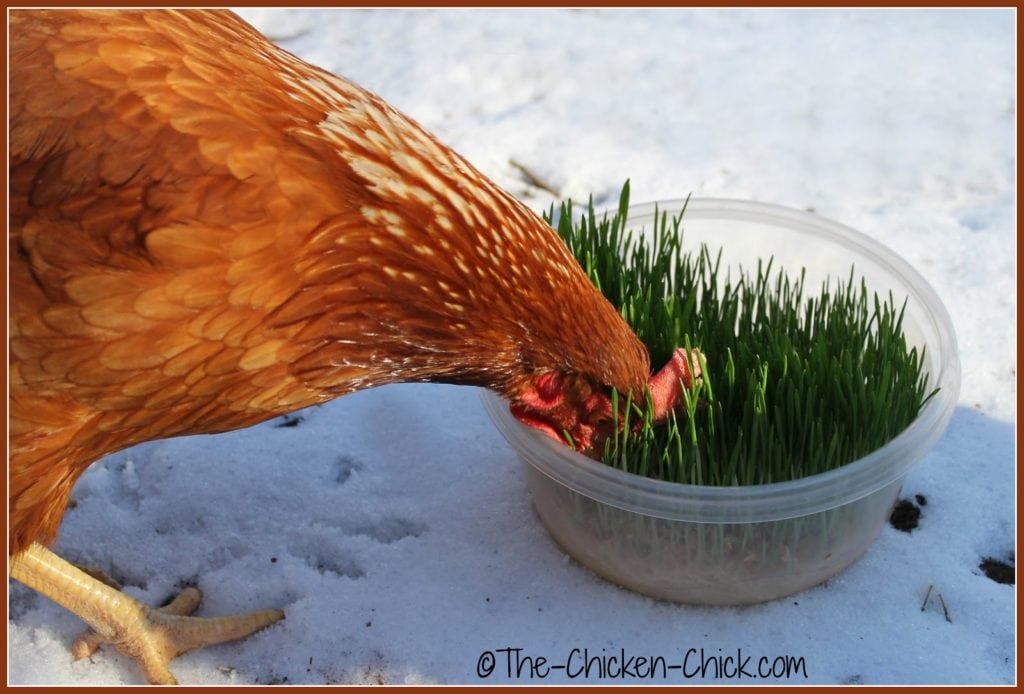
Growingsprouts is a great mode to create a foraging opportunity for chickens.

EXTERNAL PARASITES
Mites and poultry lice damage the feathers and skin of chickens. Irritation from mites and lice causes a bird to choice their own feathers and skin to obtain relief.

SOLUTION
Monitor the skin and feather wellness of birds routinely for external parasites. Providegrit bathingareas for birds to maintain the health and appearance of their skin and feathers. Loose sand or dirt are sufficient for grit bathing purposes- no additives are required or recommended.Treat all birds and coop when an infestation is discovered.

NEST BOXES- As well FEW OR Also PUBLIC
Also few
Hens will fight over nest box space, using their beaks to express their preferences. A shortage of nest boxes can result in problem picking and injuries.
Too public
When a hen lays an egg, her cloaca becomes visible as it escorts the egg out of her body. The sight of a red, moist cloaca can concenter curious flock members who naturally investigate by pecking the area.
SOLUTIONS
Brand bachelorone nest box for every four hens in a flock. Keep the nesting expanse dimly lit and private. Hangnest box curtains to ensure privacy, reduce stress and keep the cloaca from public view during egg-laying.
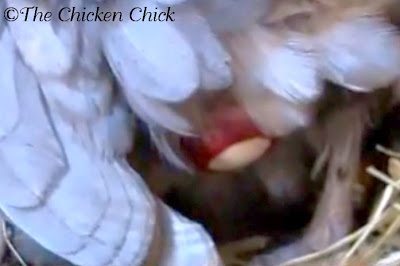
Egg laying is a especially vulnerable time for hens.Nest box curtains provide privacy and prophylactic.
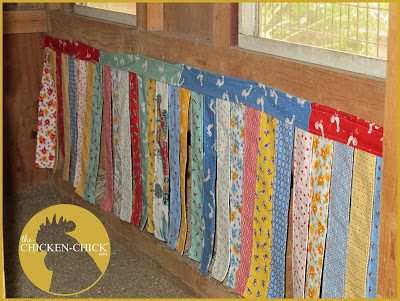
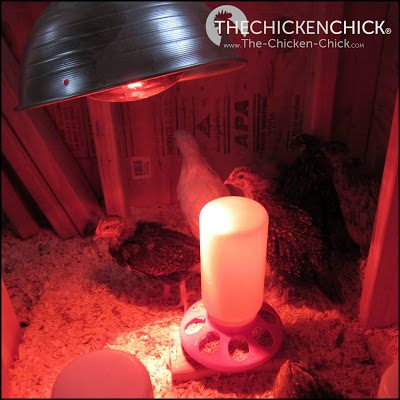
BROODER OVERHEATING
Simply as people can become irritable and prickly in the heat, then as well tin can chickens.Chicks in brooders are frequently overheated by the use of heat lamps, which increases the risk of aggression and picking behaviors.
SOLUTIONS
One solution is to provide a large enough brooder to permit chicks to escape the rut when needed and monitor the brooder temperature at both ends of the brooder with thermometers. A better solution is to apply a radiant rut source for keeping chicks warm, fugitive whatever possibility of overheating (and fire) entirely.Brinsea EcoGlow brooders are one such radiant rut choice.
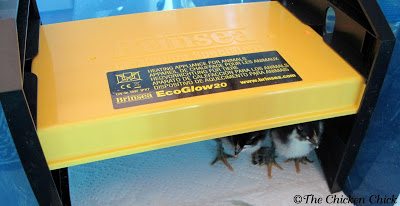
TOO MUCH LIGHT
Lights that are too bright or that are kept on too long can cause stress, agitation, aggression and picking.Brooder lampsare the main offender in the Bad Calorie-free Section. Chicks that must employ brooder heat lights should exist provided with a spacious brooder so they can escape the heat when information technology'south likewise much for them. When using a heat lamp, brooder temperatures should be closely monitored, the chicks' comfort levels gauged carefully and heat lamp use discontinued as shortly as possible. Begin raising heat lamps after the start several days of chicks' lives. Quiet chicks are content and warm enough. Noisily cheeping chicks are discontent and likely cold. Remove heat lamps entirely every bit soon as chicks no longer object to living without them.
Limit the number of low-cal hours per day to 16 for chickens of all ages. Never get out a nightlight on inside the chicken coop. Chickens must have viii hours of complete darkness in each 24 hour period.
Radiant brooder heat sources do non generate light and are much healthier, safer and more energy efficient than heat lamps. Radiant heat sources allow chicks to benefit from natural diurnal slumber-wake cycles, which we all require to be healthy. Much more than well-nigh the dangers of heat lamps and benefits of the radiant heat sources inthis article.
GENERAL STRESS
Chickens do not manage change well. To the extent possible, limit interruptions in the flock'southward routine and make any necessary changes gradually. Expect stress and proceed an eye out for picking behabiors whenever there is a housing change, a drastic weather event, apredator assail, new flock members are introduced, andafter the loss of a flock member.
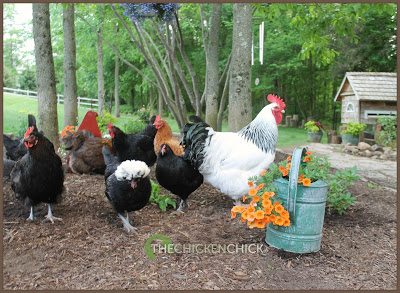
CARE OF INJURED BIRDS
Whenever a bird receives a picking injury, they must existhoused separately from the flock to avoid farther harm. Once removed to safety, wounds should be cleaned and monitored for infection. Much more information about caring for injured chickens at this link.Chicks will protestation loudly when removed from their flockmates' company andre-introduction back into the flock without disharmonize will be extremely difficult if they are kept out of sight from flockmates. I recommend separating chicks by window screening orhardware cloth within the brooder to reduce these challenges. In one case the injury has healed, re-integration is as uncomplicated as opening the "door" between the birds.
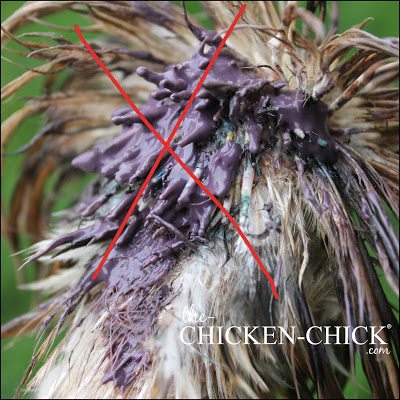
Simply SAY "NO" TO COLORED ANTI-Pick PRODUCTS!
I do not recommend products that tint the skin and feathers blue or purple for several reasons. Coloring the wound does non cover it upwardly or muffle it from flockmates, in fact, the reverse is true! Chickens take superior color vision- better color vision than humans, in fact, and a novel colored goo or spray on some other chicken's body draws unwanted attention to the area, inviting exploration and problem picking!
Further, the main ingredient of most cover-up products is alcohol, which burns like the surface of the sun on an open wound. Finally, colored wound care dyes impede the power to observe the showtime sign of infection, which is redness. Injured birds should be removed from the flock and proper wound care administered until complete healing has occurred.
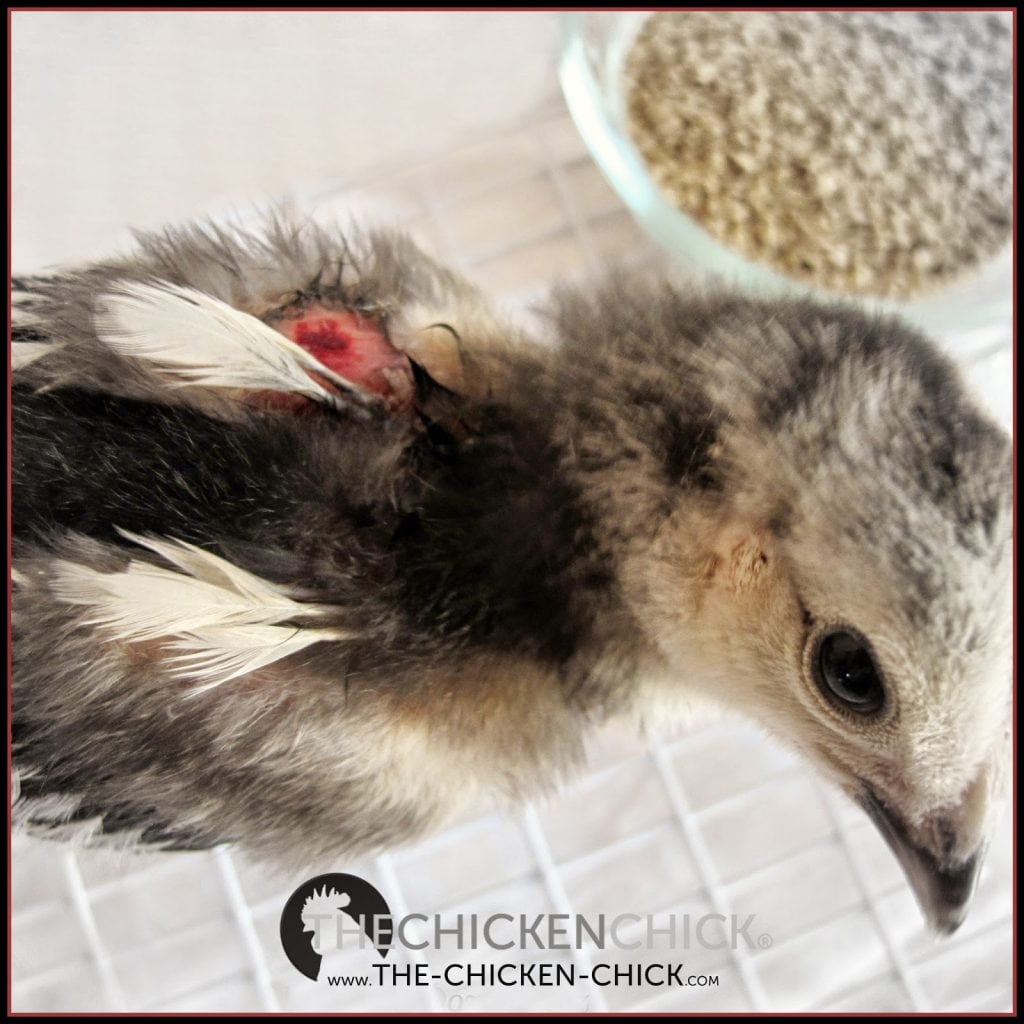
SELF-PICKING
Some chicks resort to self-subversive picking every bit my Columbian Wyandotte, Lola did. The claiming with cocky-pickers is not only separating them from other chicks, but preventing them from continuing to harm themselves. Necessity existence the mother of Invention, I fashioned a Cone of Shame for Lola out of a paper bathroom cup, which worked like a amuse! At that place were a few iterations of the Chick Cone of Shame, but one time I got it trimmed to a point where she could eat and drinkable without interference, it took just a few days for her to heal completely!
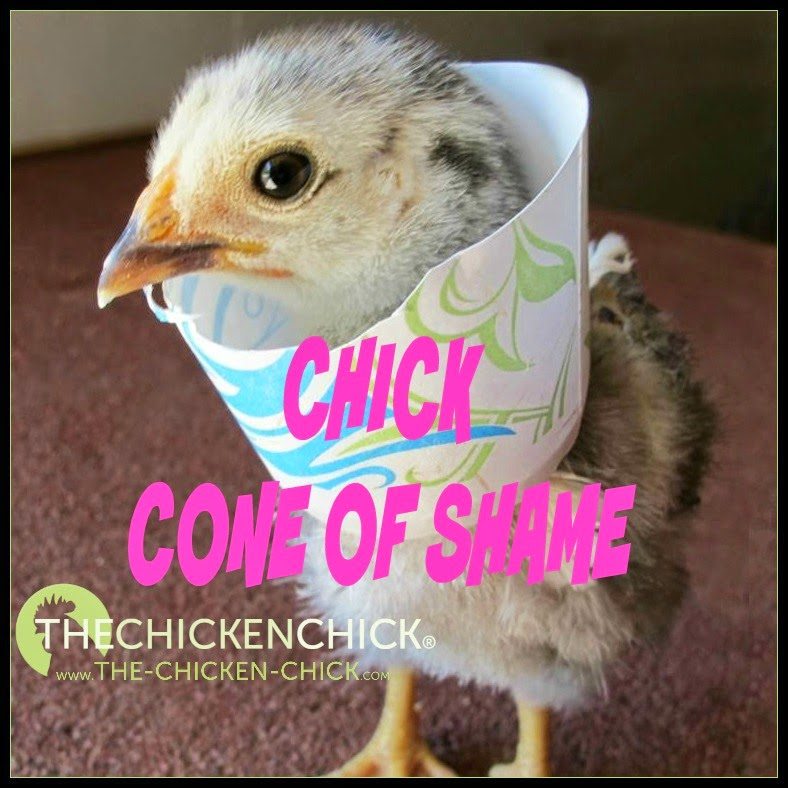
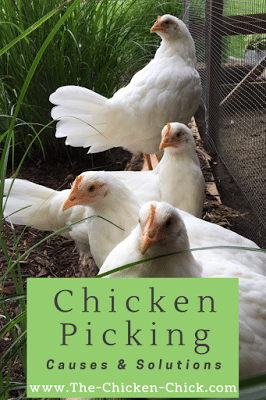
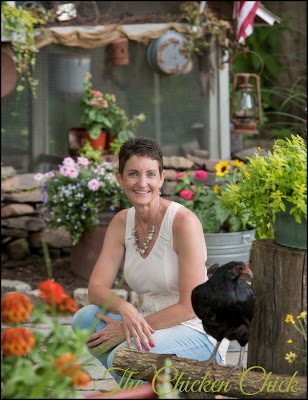

You May Also Similar
navarretesannater.blogspot.com
Source: https://the-chicken-chick.com/chicken-picking-causes-and-solutions/
Post a Comment for "What Do I Do When Baby Chicks Are Poking Eggs and Making Them Bleed"